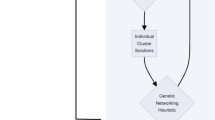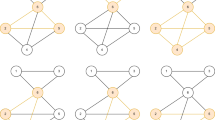Abstract
This paper presents an experimental investigation of the following questions: how does the average-case complexity of random 3-SAT, understood as a function of the order (number of variables) for fixed density (ratio of number of clauses to order) instances, depend on the density? Is there a phase transition in which the complexity shifts from polynomial to exponential in the order? Is the transition dependent or independent of the solver? Our experiment design uses three complete SAT solvers embodying different algorithms: GRASP, CPLEX, and CUDD. We observe new phase transitions for all three solvers, where the median running time shifts from polynomial in the order to exponential. The location of the phase transition appears to be solver-dependent. GRASP shifts from polynomial to exponential complexity near the density of 3.8, CPLEX shifts near density 3, while CUDD exhibits this transition between densities of 0.1 and 0.5. This experimental result underscores the dependence between the solver and the complexity phase transition, and challenges the widely held belief that random 3-SAT exhibits a phase transition in computational complexity very close to the crossover point.
Similar content being viewed by others
References
Achlioptas, D. (2000). Setting two variables at a time yields a new lower bound for random 3-;SAT. In Proc. 32th ACM Symp. on Theory of Computing, pages 28-;37.
Achlioptas, D., Bemame, P., & Molloy, M. (2001). A sharp threshold in proof complexity. In Proc. 33rd ACM Symp. on Theory of Computing, pages 337-;346.
Beame, P., Karp, R. M., Pitassi, T., & Saks, M. E. (1998). On the complexity of unsatisfiability proofs for random k-;CNF formulas. In Proc. 30th ACM Symp. on Theory of Computing, pages 561-;571.
Biere, A., Cimatti, A., Clarke, E. M., Fujita, M., & Zhu, Y. (1999). Symbolic model checking using SAT procedures instead of BDDs. In Proc. 36th Conf. on Design Automation, pages 317-;320.
Bixby, R. E. (1992). Implementing the Simplex method: the initial basis. ORSA J. on Computing, 4(3): 267-;284.
Bixby, R. E. (1994). Progress in linear programming. ORSA J. on Computing, 6(1): 15-;22.
Bouquet, F. (1999). Gestion de la dynamicite´ et e´nume´ration d'implicants premiers: une approche fonde´e sur les Diagrammes de De´cision Binaire. PhD thesis, Universite´ de Provence, France.
Broder, A. Z., Frieze, A. M., & Upfal, E. (1993). On the satisfiability and maximum satisfiability of random 3-;CNF formulas. In Proc. 4th Annual ACM-;SIAM Symp. on Discrete Algorithms, pages 322-;330.
Bryant, R. E. (1986). Graph-;based algorithms for Boolean function manipulation. IEEE Trans. On Computers, 35(8): 677-;691.
Burch, J. R., Clarke, E. M., McMillan, K. L., Dill, D. L., & Hwang, L. J. (1992). Symbolic model checking: 1020 states and beyond. Information and Computation, 98(2): 142-;170 (June).
Chao, M., & Franco, J. V. (1990). Probabilistic analysis of a generation of the unit-;clause literal selection heuristics for the k-;satisfiability problem. Information Sciences, 51: 289-;314.
Cheeseman, P., Kanefsky, B., & Taylor, W. M. (1991). Where the really hard problems are. In Proc. 12th Int'l Joint Conf. on Artificial Intelligence (IJCAI '91), pages 331-;337.
Chvátal, V., & Szemerédi, E. (1988). Many hard examples for resolution. J. of the ACM, 35(4): 759-;768.
Cocco, S., & Monasson, R. (2001). Statistical physics analysis of the computational complexity of solving random satisfiability problems using backtrack algorithms. European Physical Journal B, 22: 505-;531.
Cook, S. A., & Mitchell, D. G. (1997). Finding hard instances of the satisfiability problem: a survey. In Du, Gu, & Pardalos, eds., Satisfiability Problem: Theory and Applications, Volume 35 of Dimacs Series in Discrete Math. and Theoretical Computer Science. AMS.
Crawford, J. M., & Auton, L. D. (1993). Experimental results on the crossover point in satisfiability problems. AAAI, pages 21-;27.
Crawford, J. M., & Auton, L. D. (1996). Experimental results on the crossover point in random 3-;SAT. Artificial Intelligence, 81(1-;2): 31-;57.
Crawford, J. M., & Baker, A. B. (1994). Experimental results on the application of satisfiability algorithms to scheduling problems. AAAI, 2: 1092-;1097.
Cullberson, J., & Gent, I. P., (2000). Frozen development in graph coloring. Technical report, Department of Computer Science, University of St. Andrews. APES Research Report APES-;19-;20004.
Davis, M., Logemann, G., & Loveland, D. (1962). A machine program for theorem proving. Comm. of the ACM, 5: 394-;397.
Dubois, O., Boufkhad, Y., & Mandler, J. (2000). Typical random 3-;SAT formulae and the satisfiability threshold. In Proc. 11th Annual ACM-;SIAM Symp. on Discrete Algorithms, pages 126-;127.
Friedgut, E. (1999). Necessary and sufficient conditions for sharp threshold of graph properties and the k-;SAT problem. J. Amer. Math. Soc., 12: 1917-;1054.
Frieze, A., & Suen, S. (1996). Analysis of two simple heuristics for random instances of k-;SAT. J. of Algorithms, 20(2): 312-;355.
Garey, M. R., & Johnson, D. S. (1979). Computers and Intractability, A Guide to the Theory of NP-;Completeness. New York, NY: W. H. Freeman.
Gent, I. P., & Walsh, T. (1994). Easy problems are sometimes hard. Artificial Intelligence, 70(1-;2): 335-;345.
Gent, I. P., & Walsh, T. (1994). The SAT phase transition. In Proc. Euroropean Conf. on Artificial Intelligence, pages 105-;109.
Groote, J. F. (1996). Hiding propositional constants in BDDs. Formal Methods in System Design, 8: 91-;96.
Groote, J. F., & Zantema, H. (2000). Resolution and binary decision diagrams cannot simulate each other polynomially. Technical report, Department of Computer Science, Utrecht University. Technical Report UUCS-;2000-;14.
Hogg, T., & Williams, C. P. (1994). The hardest constraint problems: a double phase transition. Artificial Intelligence, 69(1-;2): 359-;377.
Hooker, J. N. (1988). Resolution vs. cutting plane solution of inference problems: some computational experience. Operations Research Letters, 7: 1-;7.
Jha, S., Lu, Y., Minea, M., & Clarke, E. M. (1997). Equivalence checking using abstract BDDs. In Proc. 1997 Int'l Conf. on Computer Design, pages 332-;337.
Bayardo, Roberto J. Jr., & Schrag, Robert. (1997). Using CSP look-;back techniques to solve real-;world SAT instances. In AAAI/IAAI, pages 203-;208.
Kautz, H., & Selman, B. (1992). Planning as satisfiability. In Proc. European Conference on Artificial Intelligence, pages 359-;379.
Kirk, R. E. (1999). Statistics: An introduction, fourth edition. Harcourt Brace, Fort Worth.
Kirkpatrick, S., & Selman, B. (1994). Critical behavior in the satisfiability of random formulas. Science, 264: 1297-;1301.
Larrabee, T., & Tsuji, Y. (1992). Evidence for a satisfiability threshold for random 3CNF formulas. Technical report, University of California, Santa Cruz. Technical report USCS-;CRL-;92042.
Chu Min Li, & Anbulagan. (1997). Heuristics based on unit propagation for satisfiability problems. In IJCAI (1), pages 366-;371.
Marques Silva, J. P., & Sakallah, K. A. (1999). GRASP-;A search algorithm for propositional satisfiability. IEEE Trans. on Computers, 48(5): 506-;521.
Mitchell, D. G., & Levesque, H. J. (1996). Some pitfalls for experimenters with random SAT. Artificial Intelligence, 81(1-;2): 111-;125.
Mitzenmacher, M. (1997). Tight thresholds for the pure literal rule. Technical report, Digital System Research Center, Palo Alto, California. SRC Technical Note 1997-;011.
Monasson, R., Zecchina, R., Kirkpatrick, S., Selman B., & Troyansky, L. (1999). Determining computational complexity from characteristic ‘phase transitions’. Nature, 400: 133-;137.
Nam, G. J., Sakallah, K. A., & Rutenbar, R. A. (1999). Satisfiability-;based layout revisited: Detailed routing of complex FPGAs via search-;based boolean sat. In Proc. ACM Int'l Symp. on Field-;Programmable Gate Arrays (FPGA'99), pages 167-;175.
Selman, B., & Kirkpatrick, S. (1996). Critical behavior in the computational cost of satisfiability testing. Artificial Intelligence, 81(1-;2): 273-;295.
Selman, B., Mitchell, D. G., & Levesque, H. J. (1996). Generating hard satisfiability problems. Artificial Intelligence, 81(1-;2): 17-;29.
Smith, B. M., & Dyer, M. E. (1996). Locating the phase transition in binary constraint satisfaction problems. Artificial Intelligence Journal, 8(1-;2): 155-;181.
Somenzi, F. (1998). CUDD: CU Decision Diagram package. release 2.3.0. Dept. of Electrical and Computer Engineering. University of Colorado at Boulder.
Svenson, P., & Nordahl, M. G. (1999). Relaxation in graph coloring and satisfiability problems. Phys. Rev. E, 59(4): 3983-;3999.
The VIS Group. (1996). VIS: a system for verification and synthesis. In Alur, R., & Henziger, T., eds., Proc. 8th Int'l Conf. on Computer Aided Verification (CAV '96), LNCS 1102, pages 428-;432.
Theil, H. (1979). The measurement of inequality by component of income. Economics Letter, 2.
Uribe, T. E., & Stickel, M. E. (1994). Ordered binary decision diagrams and the Davis-;Putnam procedure. In First Int'l Conf. on Constraints in Computational Logics, Vol. 845 of Lecture Notes in Computer Science, pages 34-;39, Munich: Springer-;Verlag (September).
Author information
Authors and Affiliations
Rights and permissions
About this article
Cite this article
Coarfa, C., Demopoulos, D.D., San Miguel Aguirre, A. et al. Random 3-SAT: The Plot Thickens. Constraints 8, 243–261 (2003). https://doi.org/10.1023/A:1025671026963
Issue Date:
DOI: https://doi.org/10.1023/A:1025671026963




